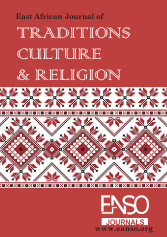Beyond Modern Science: Ryemo Gemo (Chasing Away Evil Spirits), Tradition and Faith during the COVID-19 Pandemic among the Acoli in Northern Uganda
Abstract
Background: This was a historical study of the Ryemo Gemo tradition among the Acoli people of Northern Uganda, and its implications in the context of the COVID-19 pandemic. It explored strategies indigenous people adopted for epidemic control and prevention anchored on their tradition and belief systems passed, during the COVID-19 pandemic. Methods: The study adopted the qualitative approach and ethno-historical design. It explored community meanings, beliefs, values, practices and lived experiences of Ryemo Gemo during the COVID-19 pandemic in 2020. The study was conducted in Gulu City, and the districts of Gulu, Omoro, Lamwo, Kitgum and Agago, where the ritual of Ryemo Gemo was conducted during the COVID-19 pandemic. Data was collected using Key Informant interviews, one-on-one interviews and six Focused Group Discussions. A sample size of 63 participants based on the data saturation point, and their knowledge and experience of Ryemo Gemo, was selected using the snowball and networking approach. They included: Cultural leaders, elderly persons, spiritual mediums, and health workers. Findings: Gemo was a calamity brought by bad spirits. The spirits acted as an early warning system, foreseeing and informing the people through spirit mediums of a looming calamity. Whereas Gemo was a calamity sent by bad spirits, others argued that COVID-19 was not a Gemo as it was man-made. Ryemo Gemo fostered a sense of identity, unity, and shared values, principles and practices. It promoted cultural continuity and connection between the living and the dead. Conclusion: Ryemo Gemo reflects the Acoli spirituality, beliefs and collective approach to managing calamities, reinforcing community bonds and cultural continuity
Downloads
References
Boas, F. (1902). Rudolf Virchow's anthropological work. Science, 16(403), 441-445.
Brown, P. J., Barrett, R., Padilla, M., et al. (2020). Understanding and Applying Medical Anthropology. (4th ed.). McGraw-Hill Education.
Cassel, J., Patrick, R., & Jenkins, D. (1960). Epldemiological analysis of the health implications of culture change: A conceptual model. Annals of the New York Academy of Sciences, 84(17), 938-949.
Galloway, P. K. (2006). Practicing ethnohistory: mining archives, hearing testimony, constructing narrative. U of Nebraska Press.
Geertz, C. (2017). Ritual and social change: a Javanese example. In Ritual (pp. 549-576). Routledge.
Glassie, H. (1995). Tradition. The Journal of American Folklore, 108(430), 395-412.
Graburn, N. H. (2000). What is tradition? Museum Anthropology, 24(2‐3), 6-11.
Gramsci, A. (1926). Selections from the prison notebooks of Antonio Gramsci. New York, USA: International Publishers. Reprint 2014. Translated by Hoar, Q., H. and Nowell Smith, G. 1971.
Hewlett, B. S., & Amola, R. P. (2003). Cultural contexts of Ebola in northern Uganda. Emerging infectious diseases, 9(10), 1242.
Hill, D. M. (2009). Traditional medicine and restoration of wellness strategies. International Journal of Indigenous Health, 5(1), 26-42.
Janes, C. R. (2017). A reflection on medical anthropology and epidemiology. Medicine Anthropology Theory, 4(2).
Krech III, S. (1991). The state of ethnohistory. Annual review of anthropology, 345-375.
Kumar, R. (2011). Research Methodology 3rd ed.
Lock, M. M., & Nguyen, V. K. (2018). An anthropology of biomedicine. John Wiley & Sons.
Mbunge, E., Akinnuwesi, B., Fashoto, S. G., Metfula, A. S., & Mashwama, P. (2021). A critical review of emerging technologies for tackling COVID‐19 pandemic. Human behavior and emerging technologies, 3(1), 25-39.
Mwaka, J. O., & Ochola, E. (2021). Harmony and tension in integrating Indigenous responses to covid-19 in Uganda. Journal of Management, Spirituality & Religion, 18(5), 425-443.
Odongoh, S. A. (2022). Ryemo Gemo (Chasing Away Bad Spirit): An Ethnography of Acholi Cultural Approach to Epi/Pandemic Management in Northern Uganda. In Societal Resilience and Response to Contagious Diseases and Pandemics (pp. 260-273). IGI Global Scientific Publishing.
Olukya Godfrey (2021, July 28). Ugandans turn to cannabis, other local herbs to treat COVID-19. Anadolu Agency.
Panter-Brick, C., & Eggerman, M. (2018). The field of medical anthropology in Social Science & Medicine. Social Science & Medicine, 196, 233-239.
Paul Victor, C. G., & Treschuk, J. V. (2020). Critical literature review on the definition clarity of the concept of faith, religion, and spirituality. Journal of Holistic Nursing, 38(1), 107-113.
Renner, E. (2007). Ethnohistory as a Development-Dependent Research Model, Discussed with Reference to Iroquoian Studies. Culturas en movimiento: contribuciones a la transformación de identidades étnicas y culturas en América, 93.
Trostle, J. A., & Sommerfeld, J. (1996). Medical anthropology and epidemiology. Annual Review of Anthropology, 25(1), 253-274.
Vansina, J. M. (1985). Oral tradition as history. Univ of Wisconsin Press.
World Health Organization (2000). General Guidelines for Methodologies on Research and Evaluation of Traditional Medicine. Geneva.
Copyright (c) 2025 Agatha Alidri, Simon Okello, Ochen Patrick, Ochan Demas Tukupe, Onek Richard Aure

This work is licensed under a Creative Commons Attribution 4.0 International License.




























